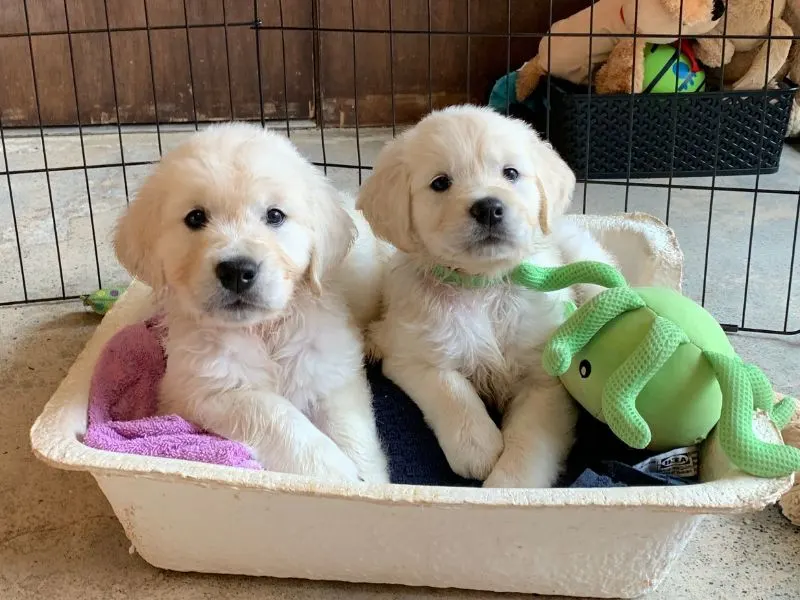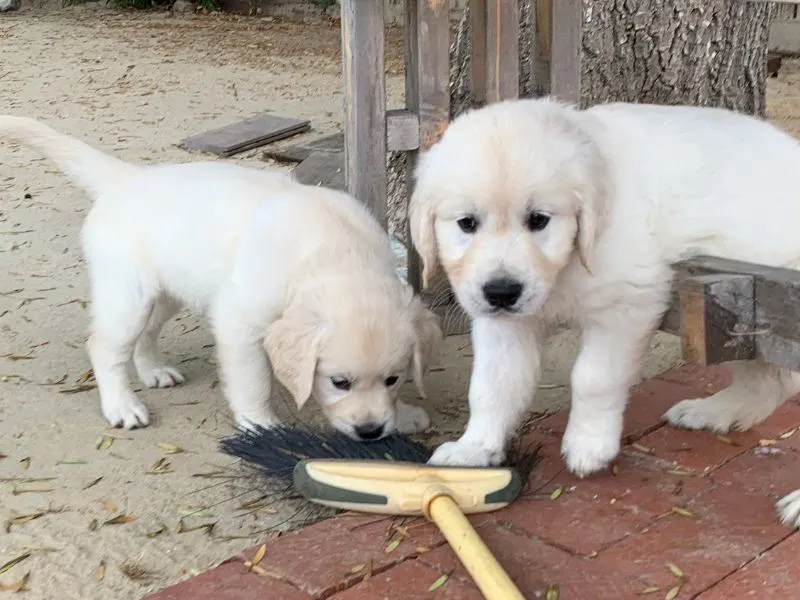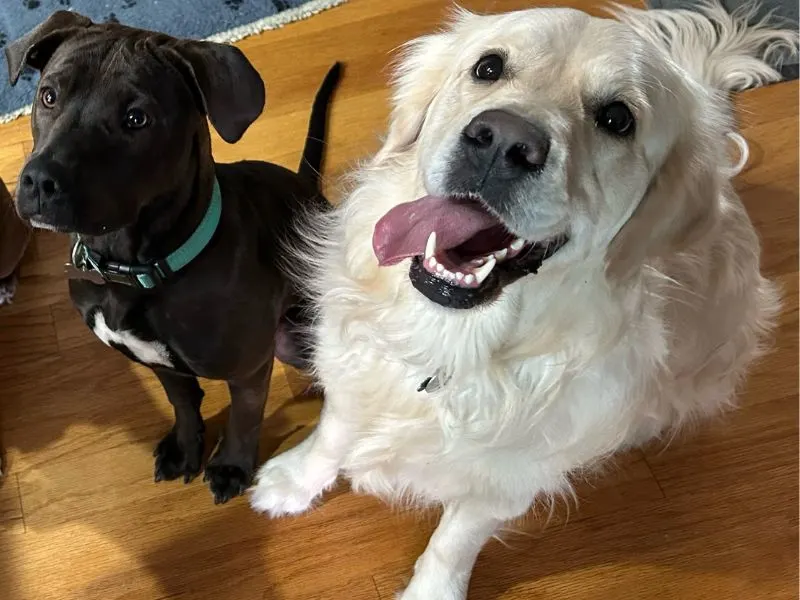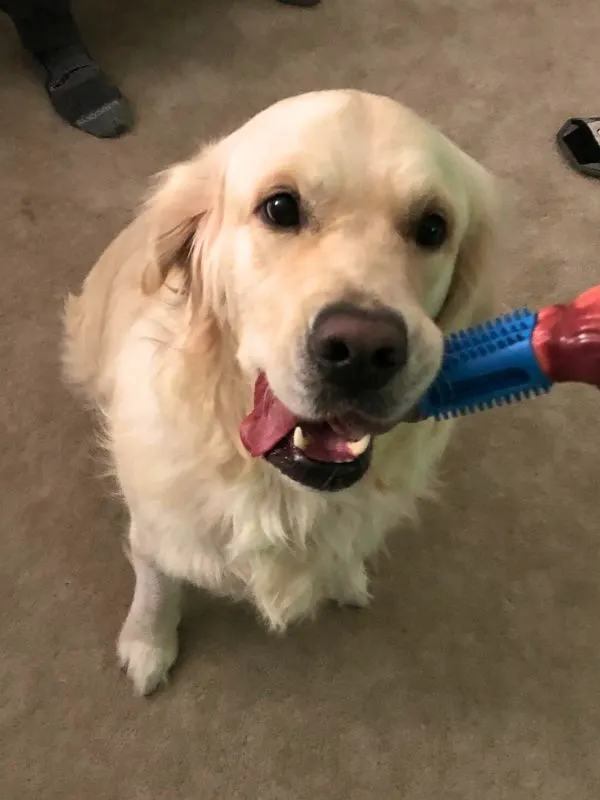Puppyhood is such an exciting, challenging time. It goes by so quickly.
Over the course of their development, puppies develop physical, cognitive, and social skills and pass through various phases.
It’s important that you know what occurs during all stages of puppy development so that you can meet your pup’s needs.
After all, you want him to be the best dog that he can be.
Understanding what to expect is crucial for your pup to grow into a healthy, well-adjusted adult.
In this article, I’ll describe what occurs at each stage of a puppy’s development so that you won’t be alarmed and can meet your puppy’s needs.
It’s important to know what not to do too when raising a puppy.
Stages of Puppy Development
The schedule set forth below is a general guideline. Each individual puppy advances at his own rate so don’t panic if your pup progresses at a different pace.
Generally, puppies aren’t sent to a new home until they’re at least eight weeks old.
It’s important that they remain with their mother and littermates to learn important lessons such as bite inhibition.
1. The Neonatal Stage (0 to 2 weeks)
Newborn puppies are dependent on their mother for just about everything: food, warmth, and keeping them clean.
Their mother washes the puppy’s bottom, licking his rear to stimulate elimination, and swallowing any waste to keep the puppy clean.
Although they have hair or fur, a puppy can’t yet regulate his body temperature.
They have no teeth and are dependent on their mother for food. Newborn puppies have voracious appetites and should eat often.
Puppies have the senses of taste and touch at this time.
They are able to drag themselves to their mother for food and to their mother, siblings, or heat lamp for warmth.
Week 1
During his first week and a half, a puppy’s development is amazing.
He may double in weight and he’ll start to appear more like a dog than a guinea pig.
In addition to appearing more stout, he’s also becoming stronger.
Although his eyes aren’t yet opened, they are preparing to open soon.
Week 2
By the second week, a puppy’s eyes are usually fully or at least partially opened.
And his world literally will be more stimulating because his ears will open up and he can hear what’s around him.
A puppy will become more mobile. He has the strength to crawl and even very briefly stand, but will often fall down.
He will begin to recognize his siblings and mother.
At this stage, he needs only his mother’s milk to grow.
As part of his social development, his breeder should gently handle the litter to get the puppies used to human touch and have a positive association with people.
2. The Transitional Period: A Sensory Awakening (2 to 4 weeks)
Puppies start to develop personalities during this phase.
They can wag their tails, bark, stand, and even walk a short distance. They also interact with their littermates.
A puppy’s sensory development rapidly continues through his sense of taste, vision, and hearing.
His eyes should be open by the end of this period, and his teeth will begin to peek through his gums. He will become responsive to the sounds, light, and movement around him.
Because he’s becoming aware of his environment, it’s important to ensure that nothing can startle or scare him.
Negative experiences such as sudden changes, loud noises, or unusual sights may negatively affect his development and personality.
A puppy should start to recognize people that he’s around frequently. And he should still be gently handled by people during this time so that he has a positive association with humans.
Puppies still need to remain with their mother and littermates. They’re still learning how to “be a dog” and interact with other canines.
Week 3
By three weeks old, a puppy has become much stronger.
Littermates start to appear differently and they become distinct individuals. They also can stand, sit, and walk around.
The individual personalities come out as the puppies play growl and interact with each other.
Because their deciduous baby teeth are appearing, some breeders even start having them taste solid food. Some breeders soak the kibble in water first.
Week 4
Breeders will often make solid food a major part of the puppy’s diet at this point. So their mother doesn’t have the same feeding responsibilities at this point.
And most puppy mothers start to lose interest in cleaning the litter up and take longer breaks from the puppies.
With better bowel control, puppies generally will move away from littermates when pooping.
It’s then left up to the breeder to do potty clean-up so that the puppies don’t indulge in the feces as a snack.
Guess what, the pups will eat their poop if you don’t clean up. Mama dog will also perform cleanup and some like my dog will cleanup even when the pups are 8+ weeks old!
By the fourth week, puppies are progressively appearing more canine-like.
They happily play with littermates and vocalize when interacting with each other.
3. The Socialization Period (4 to 7 weeks)
By the time that a puppy is around four weeks old, he starts to learn some bite inhibition.
When playing, the puppy’s siblings will correct him if he gets too rough. And his mother will also teach him manners by correcting him, so he’ll learn that she is in charge.
People shouldn’t correct the puppy for mouthing or housetraining indiscretions at this age. Let the puppies’ mother do the job until they are older.
It’s very important that the breeder handles the puppies every day. But they shouldn’t be separated from their siblings for more than 10 minutes a day.
If they’re separated too soon, puppies may have training and socialization issues and may be more likely to bark and bite.
When I was choosing my shelties from a breeder, I visited the litters during this period to tentatively select a puppy.
When I chose my sheltie Duffy, I saw that he wasn’t the feistiest nor the shyest of the litter.
He was a middle-of-the road pup who played with his littermates. Sometimes he was on top, then on the bottom as the puppies tumbled around in play.
Duffy turned out to be a great, confident dog who even became a therapy dog and top obedience sheltie.
He fit in with my other dogs and got along with everyone.
Week 5
The puppies will now be eating solid food a few times daily and are gradually weaned off their mother’s food.
Their mother now spends less time with the litter but the pups still feed from her briefly when she returns to them. And she’ll correct them if they bite too hard.
Socialization to new sights, sounds, and smells that the puppies will face in their everyday life with people is extremely important to have a confident dog later.
A puppy should also have positive interactions with a wide variety of people. Of course, the breeder should ensure that all people are calm and gentle with the pups.
The breeder of two of my shelties, Amber and Duffy, made sure throughout their development that friendly people would interact with the litters.
The breeder even made videos of some of the daily interactions with new people and of new experiences so that I could enjoy their “puppyhood.”
The breeder also made sure that the litters they raised were exposed to normal items, sights, and sounds that they would potentially face during their lifetimes.
So the litters would be kept for part of the day in the kitchen when it wasn’t too busy.
And they would spend some time in the family room when the TV was playing at a low volume.
Placing them for short times in different areas of the breeder’s home also exposed them to different surfaces such as tile, wood, and carpet.
Partially because of their solid upbringing, Amber and Duffy had bomb-proof temperaments and they loved people and other dogs.
They even became therapy dogs and nationally-ranked obedience dogs.
Week 6
By week six, a puppy should be fully weaned from his mother’s milk, eating several small meals of solid food every day.
Puppies should still remain with their mother and littermates at this age so that they learn bite inhibition.
This occurs because littermates and their mother will correct a puppy who bites too hard, so the puppy learns to mouth gently without too much pressure.
The puppy is still rapidly growing physically.
Week 7
Puppies shouldn’t go to their new homes until they are at least eight weeks old.
So this is often the final week that a puppy spends with his littermates and mother.
4. Second Socialization and Fearful Period (8 to 12 weeks)
This is a very trying time when raising a puppy. Puppies often go to their new homes during this period.
Even a formerly confident, outgoing puppy may suddenly become fearful of many things.
Some pups may become fearful of everything and others of just a few things–even things that they were previously fine with.
A puppy may show fear by:
- Shaking
- Hunching down
- Tail pulled under his body
- Flattened ears
- Backing away
- Hiding (including behind you)
- Drooling
- Submissively urinating
- Barking
- Growling
- Baring teeth
- Raised hackles
It’s crucial that you don’t force your puppy too quickly to approach items, situations, animals, or people that he fears. Doing so can result in life-long fears and even in aggressive behavior.
Make sure that your puppy is exposed to friendly, calm people so that he has positive experiences with them.
But also ensure that he isn’t exposed to anything that could be scary to him, such as loud noises or people, harsh treatment, or fearful events.
Vets generally suggest that trips to new places should wait until your puppy is fully vaccinated so that he’s not exposed to deadly diseases like parvovirus.
Of course, make sure that your puppy is receiving appropriate vaccinations for his age.
At this age, puppies can usually sleep through the night because they have better bladder and bowel control.
During this period, puppies form strong attachments to people.
Keep things upbeat when he’s exposed to new people. Make it a positive experience in a controlled environment.
Puppies are little sponges at this time and will soak up new knowledge and experiences.
So it’s a good time to start training your puppy. Keep it fun, with short sessions of a few minutes each.
Teach name recognition, attention, come, sit, and down. You can also start to teach him to walk on a leash.
Week 8
This is such an exciting time because it’s often the week when a puppy goes to his new home.
So puppy proof your home and have everything ready for your new canine addition, including a vet visit.
Of course your puppy will go through an adjustment period. After all, he’s leaving everything he knew–including his mother and siblings.
Have patience with your puppy.
You can start crate training after your new puppy’s adjusted to his new home for a few days.
Week 9
After about a week in your home, your new puppy is starting to bond with you and become adjusted to his new environment.
Have friends over to gently greet him.
If you take him to new places, make sure that they aren’t where other dogs have been. This usually means carrying him.
I’ve taken my puppies to stores other than pet stores at this age and beyond.
I bring a soft dog bed and place it in a shopping cart for the puppy’s comfort.
I do this at an “off” time when it won’t be overwhelming to the puppy.
I keep it upbeat and have a few tiny treats and some of the puppy’s kibble that I can give should people approach and when the pup’s exposed to new sights and sounds.
I remember when I took my tiny shih tzu puppy China in a department store and she was in a shopping cart. Another shopper was nearby and looked our way.
When China moved, the woman was startled because she thought that China was a stuffed toy.
The woman came by and petted China while I gave the pup a few pieces of kibble.
Because her breeder laid a solid foundation which I continued, China developed into a confident, friendly dog.
She loved everyone and became a therapy dog and top-rated obedience shih tzu.
Weeks 10 and 11
These are very important socialization weeks. You should expose your puppy to new people, sounds, and sights that he will face in everyday life as long as they aren’t overpowering.
Week 12
This is a point at which a crucial socialization window closes.
This means that it’s a critical time to continue socializing your pup to new people and experiences that are positive.
You want your puppy to become a well-adjusted, friendly, confident dog.
The effort that you put into his education at this point will pay off throughout his life.
Of course, socialization should still occur for the duration of his life.
5. The Juvenile Stage (3 to 4 months)
At this point, your puppy will become more challenging and may literally test your authority. But don’t give up.
Just keep reinforcing his commands.
His play biting may become more persistent. Make sure that you have toys ready to redirect him to chew safe ones rather than your skin.
Don’t engage in wrestling or tugging or your puppy may believe that behavior is what you desire–and he may even think that he’s “won” the encounter and become more insistent during the next play session.
It’s important that your puppy learns to bite softly prior to adolescence should his teeth accidentally touch you.
Puppies also use their teeth when playing with other puppies, so, unless he was a singleton (the only puppy in the litter), he should already have some bite inhibition.
In teaching your puppy to keep teeth off of people, don’t reward that behavior.
You can calmly say “ouch” when his teeth are on you, and immediately walk away from him for at least 20 seconds. Then return. Just do this a few times.
He should get the idea that interaction and play ends when his teeth are on humans.
Also always have safe toys and chews to redirect his little needle teeth to appropriate chew items.
Mouthing and puppy biting will also occur because your puppy may be starting to lose his puppy teeth.
His gums are sore and he’s trying to relieve the pain by biting.
His house training should be becoming more reliable. But he will probably still have some accidents.
6. The Ranking Period (3 to 6 Months)
Puppies become increasingly independent during this time.
They will challenge your authority and be more headstrong and self-sufficient.
Puppies will test their limits and become somewhat disobedient.
They are trying to establish their place in the pack and may demonstrate dominant behavior over people in your family–especially over children.
As your puppy increases his social skills, his personality will become more evident, such as whether he is dominant, submissive, or middle-of-the road.
It’s important to keep training them to have control in a positive way.
Don’t give any command that you can’t enforce. At this age, a puppy is still learning basic cues and isn’t reliable around distractions.
So don’t let your puppy off leash if not in an enclosed space such as a room or securely fenced area without other animals.
A puppy can swiftly take off and become lost, injured, or worse.
Keep teaching him his basic commands, even performing his recall on a longline.
Puppies during this period are little land sharks. Their needle teeth are extremely sharp and their gums are sore as they lose the remainder of their puppy teeth.
Have KONGs and other safe chews available so that you don’t become their pin cushion.
7. Adolescence (6 to 18 Months)
In this final development stage, your puppy will start to look like a mature dog during this period.
But don’t be fooled. He still has a lot of growing to do as far as his maturity and mental capacity are concerned.
Generally, smaller breeds reach emotional and physical maturity sooner than larger breeds do.
A normal adolescent is very energetic, spirited, and ready to learn new things.
Keep training him regularly to basic cues with more distractions as he’s able to handle them. And start teaching new behaviors such as tricks.
Also make sure that he has a sufficient amount of exercise (walks, fetching) to help curb destructiveness.
Keep socializing him to new situations, new people, and friendly dogs.
Some puppies even experience another fear period during this time. So don’t be alarmed.
But don’t force him into situations that he’s not ready to handle. This is called flooding and it can result in fight, flight, or freeze behavior by your pup.
And it could lead to lifelong fears.
Instead, expose him to things at a distance and level that he can handle.
Depending on what the fear is, you can try counter-conditioning him to it and, over time, desensitizing him to it.
My Aussie mix rescue Millie had a fear period around seven months old. She loved to go to a nearby pet store.
But, out of the blue, one day on our excursion, she was very fearful. Nothing that I could tell in the environment had changed.
She cowered, pulled her tail between her legs, and her ears were pinned back. I gave her a few treats and we left.
The next time we went, she was more like herself. So I made it a party: treats, praise.
We returned a few days later and she was her confident, normal self.
Most adolescent puppies will explore their environment and won’t stay by your side as they did when they were a few months old.
Walk your puppy around your neighborhood so that he can sniff and learn who’s been there and so that he sees and hears what he will face for the rest of his life.
By six months old, most puppies have lost their puppy teeth. But they’ll still have a desire to chew, so be prepared with safe chews.
And often they’ll receive two instead of three meals.
Some females will go into heat around six months old or so. So make sure to keep your female adolescent puppy away from roaming males.
Vets used to routinely say to spay or neuter a puppy at six months old.
However, recent studies suggest that early spay/neuter can adversely affect a canine’s physical and emotional health.
So make that decision with that knowledge in conjunction with your vet.
FAQs
Why does my puppy have to stay with his breeder until he’s eight weeks old?
Puppies should remain with their mother and littermates until that age because their mother and littermates help teach a puppy certain behaviors such as bite inhibition.
A puppy also begins to understand pack order by remaining until that age.
Is my puppy fully mature when he’s a year old?
Not really. He may look like an adult dog but, in reality, he’s still maturing emotionally and his mental capacity is still developing.
Suddenly, my nine-week-old puppy is afraid of a chair in the family room. He used to love to lie there, but now won’t even pass by it and shakes when he’s near it? Should I pick him up and place him there?
No. He’s probably just going through a fear period. It should pass, especially since he already had confidence when near the chair.
You can help him by using small treats or a few pieces of his kibble when he looks at or is near the chair. You want him to have a good association with it.
Final Thoughts
Puppyhood goes so quickly. Enjoy it.
To have a confident, happy, trained, sociable adult dog, you need to be aware of the phases of development that your puppy will pass through.
At each milestone, your puppy will have certain needs. Once you understand the phases of development, you can help him along to be the best pup that he can be.
Do you have a puppy?
Has he had any fear periods or challenging behaviors?
How did you handle them?
Please tell us about it in the comments section below.








